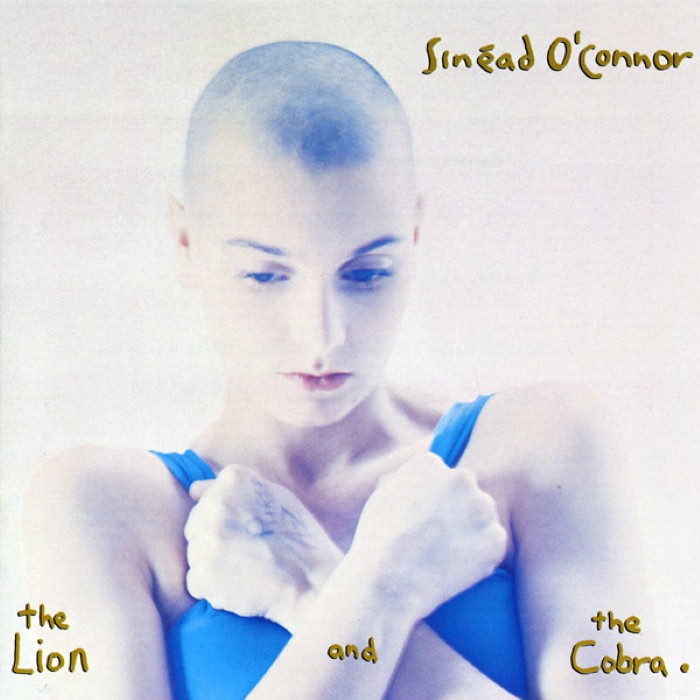The Lion and the Cobra by Sinéad O'Connor

The Lion and the Cobra is the 1987 debut album by Irish singer Sinéad O'Connor. O'Connor, age 20 at the time, recorded the album while heavily pregnant with her first child. The photograph of O'Connor on the album cover was taken by Haysi Fantayzee member Kate Garner. The U.S. cover differed from the European release, as it was felt a more subdued pose would present a "softer" image of O'Connor. The video for "Mandinka" was shown heavily after debuting 24 January 1988 on 120 Minutes on MTV. The single was a mainstream pop hit in the UK, peaking at #17 in the singles chart, as well as her native Ireland. "I Want Your (Hands On Me)" debuted in May 1988 on the same show, featuring a rap interlude by MC Lyte. The song was featured in the 1988 horror film A Nightmare on Elm Street 4: The Dream Master. The album featured prominent session musicians John Reynolds on drums, former Adam and the Ants and Siouxsie and the Banshees guitarist Marco Pirroni and Mike Clowes Friction Groove . The title of the album is from Psalm 91:13 "you will tread upon the lion and cobra", and the track "Never Get Old" opens with an Irish language recital of Psalm 91 by singer Enya. Additional single b-sides include "Still Listening" and "The Value of Ignorance". The album sold 2,500,000 copies worldwide. Slant Magazine listed the album at #46 on its list of "Best Albums of the 1980's saying "The Lion and the Cobra is regal, majestic, and allegorical, an album rife with images of war, slain dragons, and ghosts, and it's one of the most electrifying debuts in rock history".
As a kid, Sinéad O’Connor’s biggest inspiration was the boxer-activist Muhammad Ali. It wasn’t his physical strength, she said—if anything, she found the image of Black men fighting for the entertainment and financial gain of mostly white men unsettling. But in Ali’s claim to be both the greatest and the <i>prettiest</i>, O’Connor—a victim of child abuse whose Catholic upbringing always invited her to think less of herself—realised that power could be beautiful, and that if a Black man in the Jim Crow South could transcend his station, then she might be able to, too. That confidence comes through on O’Connor’s 1987 debut, <i>The Lion and the Cobra</i>—an album whose calling card is its volatility. On <i>The Lion and the Cobra</i>, the rippers rip (“Mandinka”), the funk twitches (“I Want Your (Hands On Me)”) and even the album’s mellower tracks bristle with a weirdness that can’t quite be sanded down (“Jackie”, “Never Get Old”, “Troy”). O’Connor’s power lies not just in her shriek, but also in the way she controls it—a balance of punk primitivism and adult-contemporary sophistication that carried the torch of Patti Smith, and paved the way for Björk. A handful of the songs on <i>The Lion and the Cobra</i>—including the unsettling “Drink Before the War”—were written when O’Connor was as young as 15, and you can tell: <i>Cobra</i> doesn’t contain or describe feelings—it expresses them, and in all their ugly, lopsided glory. The resulting record is so raw and engaging, no one was quite sure what to make of it at the time. <i>The Lion and the Cobra</i> shifted currents within both underground circles and the mainstream, redefining pop and singer-songwriter conventions a time when the idea of “alternative” music was just coming into play. O’Connor was hard to categorise—but even harder not to admire, given her strength and outspokenness. At the 1989 Grammy Awards, she performed “Mandinka” with the Public Enemy logo dyed into her hair—proof that she’d forever carry herself as an outsider, no matter how high her profile might rise. And as for Ali? O’Connor wound up meeting her hero in 2003, at the Special Olympics in Dublin. The boxer’s Parkinson’s disease was by that time so advanced that he had trouble getting his jacket on. “He’s asking me for help,” O’Connor would later recall in her memoir, <i>Rememberings</i>. “This is my father. I’m helping my father to put his jacket on.” Pure, true, direct: That was her art.
